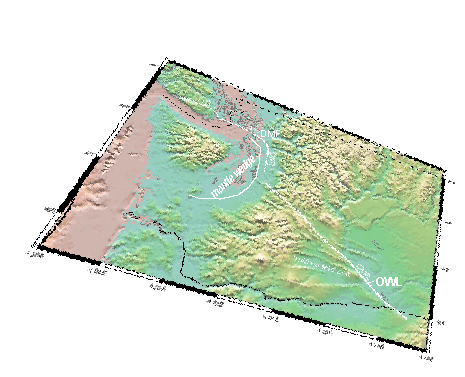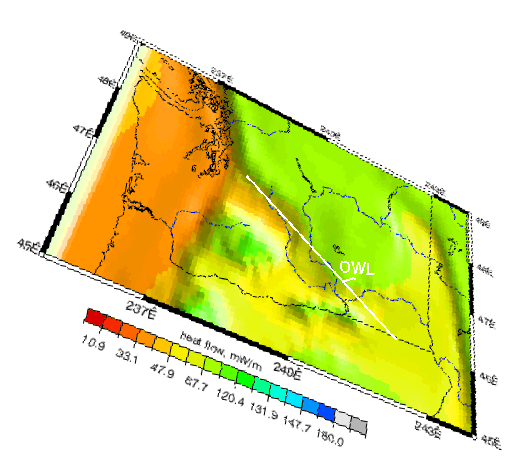| Prev |
| Next |
| Map |
This view is of a velocity isosurface at 7.0 km/s taken from a larger, regional model that covers most of Washington State. The cell sizes were 10 km x 10 km x 2 km and because of the memory requirements, the model only extended to 22 cells vertically (44 km from top of model). Thus, the subducting Juan de Fuca plate was not imaged well, except on the axis of the arch in a small region. However, this regional model gives a more comprehensive look at structures influencing the subducting plate and other tectonic aspects. The mantle wedge is outlined by the thin white line. The 'gap' in the mantle wedge shown in previous images is also evident, but of slightly more irregular nature, since we used an isosurface of 7.0 rather than 7.5 km/s, as in the earlier images. Including more of the upper surface of the mantle wedge causes the additional irregularity. A tectonic buttress provided by older crust in the North Cascades and southwest BC is clearly indicated as relief in the isosurface. Oblique motion of the JDFP and mantle wedge are resisted by this buttress. Important regional faults such as the Devils Mount fault (DMF) follow the edge of this crustal buttress. Also, the elevated high velocities of the buttress extend into a NW-SE trending feature known as the Olympic Wallowa lineament (OWL). The OWL is indicated by the white line where it cannot be traced on the isosurface. We interpret that the OWL is related to a deep shear zone in the crust and upper mantle which guides Pacific plate shear acting in the Basin and Range province back out to the Queen Charlotte transform. This shear is interpreted to exit along the edge of the buttress shown. A relief map with surface expression of the OWL, DMF, etc. is shown on the right. When compared to the heat flow map (right), it is clear that the buttress area and other parts of northwestern and northcentral Washington have high heat flows. Note the low heat flow in the coast ranges of Washington and Oregon due to the effect of the subducting Juan de Fuca plate. The significance of these joint observations is still being analyzed, but it is clear that the heat flow boundary and OWL also strongly influence stress patterns in Washington (click here to jump to stress models).
Return to:Subduction Zone Dynamics Intro | PACNW | Earthquake Hazards | Central Region | USGS

